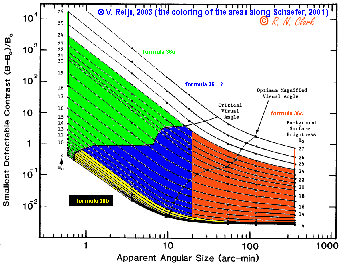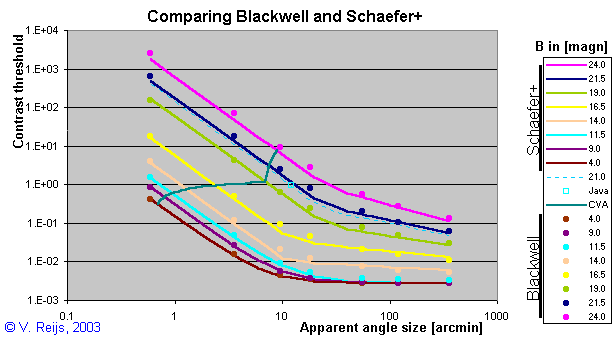 Home
Home Up
Up Search
Search Mail
Mail
NEW
Assumptions on calculations of limiting visual magnitude,
extinction angle and shadow casting
The JavaScript implemented is partly
based on the JavaScript program written by Larry Bogan (same basic changes are done by
Victor Reijs on Bogan's core),
which was on it's turn based on the BASIC program (the former
errors have been corrected) and theory provided by Bradley E.
Schaefer. See also a
copy of Schaefer [2000] (with permission of the editor of
Arhaeoastronomy).
Several additions, changes, open questions and assumptions have been
made:
- two Bsky models are defined:
- Arch. XI
Archaeoastronomy XI [1993].
This model is not described anymore in the latest article of
Schaefer [2000], so I assume
this one is not valid for my purposes. This model is implemented
by Ben Sugerman in JavaScript
- The dimensions of the Bx in Arch XI are
in [nL].
- Arch XV (used by my calculations)
Archaeoastronomy XV [2000]
comparable with Sky and Telescope [1998] (BASIC program provided
by B. Schaefer and JavaScript of Bogan).
- Some typo's in Arch XV are discussed here.
- In Arch XV the V (Visual magnitude) is the only option
used of the UBVRI magnitudes, so that photometric formula
(eye depending) can be used.
The two Bsky models behave quite differently. The
differences are (these have no influence when the sky is really
dark):
- It looks that in Arch XI one argument of the phase function
f (r), mentioned in
Arch XV, is not used. Deleting this argument
(440000*(1-10-0.4kX)) in Arch XV one gets almost
the same results.
- Bnight (in [nL]) in both models are comparable
(although the value of B0 in Arch XI is unknown,
taken as 180 by me).
- Bmoon (in [nL]) in Arch XI is always smaller than
in Arch XV (some factor of 54 at 1° (rmoon
is 1°) and going down to a factor of 1 at 45° apparent
altitude (rmoon is
45°)).
- Btwi (in [nL]) is in Arch XI always bigger than Bday
until apparent altitude is lower than -14° (azisun-azilook
around 180°)
- Bday (in [nL]) in Arch XI is always smaller than
in Arch XV (some factor of 54 at 1° (rsun
is 1°) and going down to a factor of 1 at 45° apparent
altitude (rsun is 45°)).
Is Arch XI indeed not valid anymore? In the meantime Arch XV is
implemented.
- Is it allowed to use Dm(Z)=kR*Xe(Z)+kOZ*XL(Z)+etc.
(8b)
for
greater accuracy instead of Dm(Z)=kX(Z)
(8a)
in the Bx-formula's of Schaefer [2000]? In my calculations this (8b) is being
used.
- What formula is needed for
(log(B)<6 and QCVA<z<~20') (the blue
area)? In the below graph the approximate
formula-boundaries provided by Schaefer [1993] can be seen (the black
lines are the data of Blackwell
[1946]):

- A possible solution is using the max(formula (36a),formula
(36c)): called Schaefer+ (the dots are the data of Blackwell [1946]):

The colored lines are calculated using the
max(formula(36a),formula(36c))
The dots are the Blackwell data.
- another alternative: linearly interpolate between (36c) and
(36a) for apparent angle sizes between 10' and 100' (idea of
Thomas Schmidt).
- my JavaScript has the Blackwell [1946] table (the dots in the
above picture) incorporated using interpolation. This though
gives in most cases a higher contrast threshold than
of Schaefer.
- The conversion from [erg/sec/cm2/mm/arcsec2] to [nL] is used.
This conversion is build up as follows (see also this convertor link):
nL TO erg / second centimeter2 steradian = 3.183*10-3
lumen / watt
Taking 1 lumen = 1.464*10-3 watt as the normalized
value (for photopic vision at 0.555 mm):
1 [nL] = 4.660*10-6 / "Integral
over visible light of normalized Luminosity curve"
[erg/sec/cm2/mm/steradian]
For 1 arcsec2 = 2.35*10-11 steradian
1 [nL] = 1.095*10-16 / "Integral over visible light of
normalized Luminosity curve" [erg/sec/cm2/mm/arcsec2]
The "Integral over visual light of normalized
Luminosity curve" is 0.242 [mm]
(scotopic vision) or 0.107 [mm]
(photopic vision) over visual light of 0.36 mm
to 0.83 mm.
So the conversion value is 1.02*10-15 for photopic
vision (B>103.17 [nL]) and 4.48*10-16 for
scotopic vision (B<103.17 [nL]) (the BASIC program
has 1.11*10-15 in all cases).
It could be that something needs to be changed in the code to
reflect the boundary of photopic/scotopic vision.
This issue is solved due to the formula for the threshold, which
is different for above and below B<103.17 [nL].
- Just some other small additions/changes:
- How to derive the atmospheric extinction coefficient (kx)
from the atmospheric absorption coefficient (ßx) can be
seen here.
- The airmass has been made dependent of the air pressure.
- changed kOZ, ka and kR when
night vision is effective (sun lower than start of
astronomical twilight (Vistas in Astronomy, page 343).
- ±saW=0.01±0.4*(ka+kW)
has been used to get the skewedness of the saW (as defined in Arch XI
(6b)).
- changed Bnight in such a way that it is in pace
with sun-spot cycle (start: 1990.33 and a period: 11.1 year).
- increased contrast threshold (increased log(contrast) with
0.2) so that not 50% but 90% certainty exists in viewing the
shadow difference (Blackwell [1946]).
- included that from apparent observational altitude is
<10°, Bnight is kept constant (Vistas in
Astronomy, page 343).
- age of person has been included (using Garstang [2000]).
- the Moon's magnitude is made dependant on it's distance from earth.
- Added the concept of the sky window,
- Added model to calculate the visibility of the moon on the horizon (for lunar standstill event in 2006),
moon's shadow inside an enclosure (like a
passage monument) and heliacal events.
- Excel Add-in functions have
been made.
Disclaimer and Copyright
 Home
Home Up
Up Search
Search Mail
Mail
Last major content related changes: May 2, 2003

